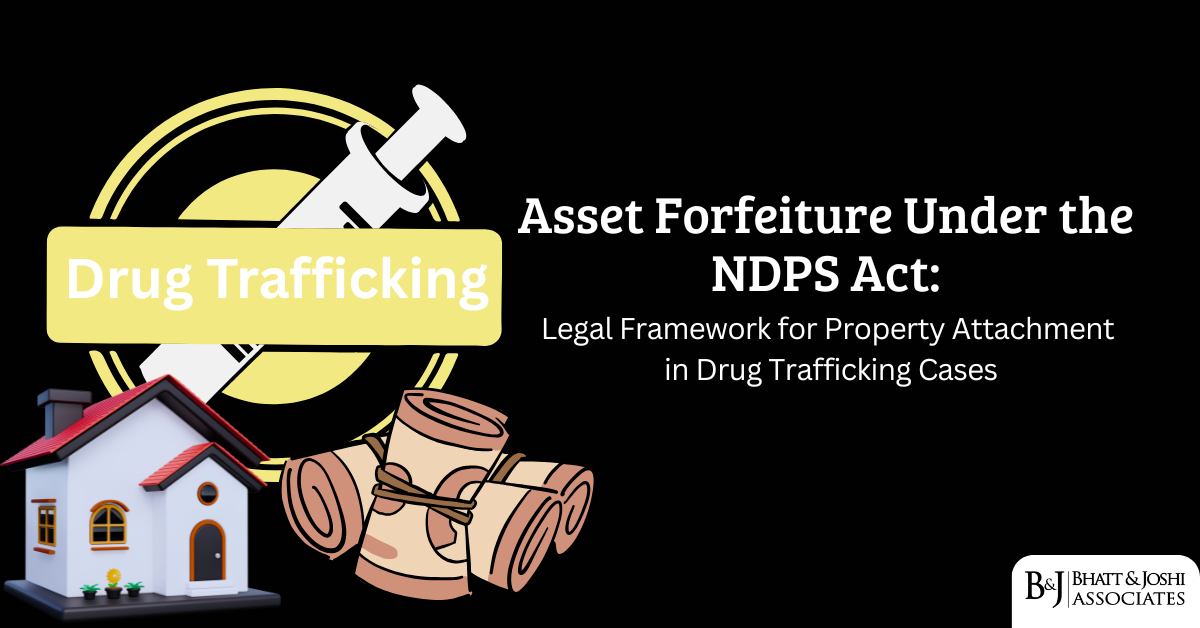Introduction
The attachment and forfeiture of properties derived from illicit drug trafficking represents a critical component of India’s anti-narcotics enforcement strategy. Recent police action in Anantnag, Jammu and Kashmir, where authorities attached immovable property worth ₹25,35,882 belonging to a habitual drug peddler under Section 68-F(1) of the Narcotic Drugs and Psychotropic Substances (NDPS) Act, 1985, exemplifies the robust legal framework of asset forfeiture under NDPS Act, designed to dismantle the financial infrastructure of drug trafficking networks [1].
The case of Parvaiz Ahmad Fashoo, a repeat offender involved in multiple drug trafficking cases, demonstrates the comprehensive approach adopted by law enforcement agencies to target not merely the physical act of drug trafficking but also the economic benefits derived from such criminal enterprises. This legal mechanism serves the dual purpose of punishment and deterrence while ensuring that crime does not financially benefit perpetrators.
The NDPS Act’s forfeiture provisions, contained in Chapter VA (Sections 68A to 68Z), form a core part of the asset forfeiture under NDPS Act framework, one of the most stringent in Indian criminal law, specifically designed to combat the profit-driven nature of drug trafficking offences.
Historical Context and Legislative Evolution
Genesis of the NDPS Act, 1985
The Narcotic Drugs and Psychotropic Substances Act, 1985, was enacted to fulfill India’s treaty obligations under international conventions, including the Single Convention on Narcotic Drugs (1961), Convention on Psychotropic Substances (1971), and the United Nations Convention Against Illicit Traffic in Narcotic Drugs and Psychotropic Substances (1988) [2]. The Act came into force on November 14, 1985, marking a significant shift in India’s approach to drug control.
Prior to 1985, India had no comprehensive legislation regulating narcotics. Cannabis and its derivatives were legally sold and their recreational use was socially accepted, similar to alcohol consumption. However, international pressure, particularly from the United States, led to the enactment of the NDPS Act, fundamentally transforming India’s drug control landscape.
Introduction of Asset Forfeiture Provisions under NDPS Act
The asset forfeiture provisions were introduced through the Narcotic Drugs and Psychotropic Substances (Amendment) Act, 1989, which added Chapter VA to the original Act [3]. This amendment was specifically designed to implement the provisions of international conventions on narcotic drugs and psychotropic substances, recognizing that effective drug control required targeting the financial incentives driving trafficking activities.
The forfeiture provisions were modeled on the successful framework of the Smugglers and Foreign Exchange Manipulators (Forfeiture of Property) Act, 1976 (SAFEMA), adapting its mechanisms to address the unique challenges posed by drug trafficking [4].
Constitutional and Legal Framework
Constitutional Validity of Asset Forfeiture under NDPS Act:
The constitutional validity of asset forfeiture under the NDPS Act is grounded in the state’s police power to protect public health, safety, and welfare. The Supreme Court has consistently upheld the constitutional validity of such provisions, recognizing that drug trafficking poses a serious threat to society and that extraordinary measures are justified to combat this menace.
The forfeiture provisions do not violate Article 19(1)(f) of the Constitution (right to property, now repealed) or Article 300A (right to property), as they provide adequate procedural safeguards and are based on the principle that no person should benefit from criminal conduct.
Scope and Application of Asset Forfeiture under NDPS Act
Chapter VA of the NDPS Act applies to specific categories of persons, as defined in Section 68B [5]:
- Every person convicted of an offence punishable under the NDPS Act with imprisonment for ten years or more
- Every person convicted of a similar offence by a competent court of criminal jurisdiction outside India
- Every person detained under the Prevention of Illicit Traffic in Narcotic Drugs and Psychotropic Substances Act, 1988, whose detention order has not been revoked or set aside
- Relatives and associates of such persons, to prevent the shielding of assets through benami transactions
Detailed Analysis of Section 68F: Seizure and Freezing Powers
Legislative Text and Interpretation
Section 68F(1) of the NDPS Act empowers authorized officers to take immediate action when they have reason to believe that property under investigation is illegally acquired and likely to be concealed, transferred, or dealt with in a manner that would frustrate forfeiture proceedings [6]. The provision states:
“Where any officer conducting an inquiry or investigation under section 68E has reason to believe that any property in relation to which such inquiry or investigation is being conducted is an illegally acquired property and such property is likely to be concealed, transferred or dealt with in any manner which will result in frustrating any proceeding relating to forfeiture of such property under this Chapter, he may make an order for seizing such property and where it is not practicable to seize such property, he may make an order that such property shall not be transferred or otherwise dealt with, except with the prior permission of the officer making such order, or of the competent authority.”
Procedural Requirements
The section mandates specific procedural compliance to ensure fairness and prevent abuse of power:
- Immediate Notification: The competent authority must be informed of any order made under Section 68F(1), with a copy sent within 48 hours of its making.
- Confirmation Requirement: Under Section 68F(2), the competent authority must confirm the seizure or freezing order within 30 days, failing which the order becomes invalid [7].
- Service of Notice: A copy of the order must be served on the person concerned, ensuring due process compliance.
Powers of Authorized Officers
Section 68E defines the officers empowered to conduct inquiries and investigations [8]:
- Every officer empowered under Section 53 of the NDPS Act
- Every officer in-charge of a police station
- Officers of the Narcotics Control Bureau
- Officers of Customs, Central Excise, and other authorized agencies
These officers have broad investigative powers, including the authority to examine financial records, property documents, and other relevant materials to trace illegally acquired properties.
Case Study: Anantnag Property Attachment
Factual Background
The recent action in Anantnag district demonstrates the practical application of Section 68F provisions. Parvaiz Ahmad Fashoo, identified as a habitual offender, was found involved in multiple cases registered under the NDPS Act:
- FIR No. 67/2019 under Sections 8/15 NDPS Act at Police Station Anantnag
- FIR No. 129/2015 under Sections 8/15 NDPS Act at Police Station Anantnag
- FIR No. 28/2017 under Sections 15/18 NDPS Act at Police Station Achabal
Property Details and Valuation
The attached property, located at Bangidar, Mir Danter, Anantnag, comprised:
- One single-storey concrete residential house
- Land measuring 07 marlas
- Estimated market value: ₹25,35,882
The property was identified during investigation as having been acquired from proceeds of illicit narcotic trade, demonstrating the direct nexus between criminal activity and asset acquisition required under the law.
Legal Process Followed
The attachment followed due legal process, with the order being forwarded to the competent authority for confirmation under the NDPS Act provisions. This procedural compliance ensures that the attachment withstands legal scrutiny and provides a model for similar enforcement actions.
Substantive Offences Under the NDPS Act
Section 8: Punishment for Contravention
Section 8 of the NDPS Act prescribes punishment for various contraventions related to narcotic drugs and psychotropic substances [9]. The punishment varies based on the quantity involved:
- Small Quantity: Rigorous imprisonment up to six months, or fine up to ₹10,000, or both
- More than Small but Less than Commercial Quantity: Rigorous imprisonment up to 10 years and fine up to ₹1,00,000
- Commercial Quantity: Rigorous imprisonment between 10-20 years and fine between ₹1,00,000 to ₹2,00,000
Section 15: Enhanced Punishment for Certain Offences
Section 15 provides enhanced punishment for repeat offenders and those involved in organized trafficking activities [10]. The section recognizes that habitual offenders pose a greater threat to society and deserve more severe sanctions.
- Repeat Offenders: Minimum 15 years imprisonment extendable to 30 years, with fine between ₹1,50,000 to ₹3,00,000
- Organized Crime: Additional penalties for those operating as part of organized criminal enterprises
Burden of Proof and Presumptions
The NDPS Act contains several provisions that shift the burden of proof or create presumptions against accused persons:
- Section 54: Presumption of culpable mental state, requiring the accused to prove lack of knowledge or intent
- Section 35: Presumption regarding possession of narcotic drugs in certain cases
- Sections 68J: In forfeiture proceedings, the burden of proving that property is not illegally acquired lies on the affected person
SAFEMA Integration and Competent Authority Framework
Role of SAFEMA in NDPS Enforcement
The Smugglers and Foreign Exchange Manipulators (Forfeiture of Property) Act, 1976, provides the institutional framework for implementing forfeiture orders under the NDPS Act [11]. The Competent Authority under SAFEMA has been empowered to handle NDPS forfeiture cases, creating a unified system for asset recovery.
This integration ensures specialized expertise in handling complex financial investigations and provides consistency in forfeiture proceedings across different statutes. The Competent Authority, typically appointed by the Central Government, possesses the necessary powers to effectively implement forfeiture orders.
Appellate Tribunal Structure
The Appellate Tribunal constituted under SAFEMA serves as the appellate forum for challenging forfeiture orders under the NDPS Act [12]. This tribunal, originally established as the ‘Appellate Tribunal for Forfeited Property’ (ATFP) in 1977, has evolved to handle appeals under multiple statutes including:
- SAFEMA (1976)
- NDPS Act (1985)
- Prevention of Money Laundering Act (2002)
- Foreign Exchange Management Act (1999)
- Prevention of Benami Property Transactions Act (1988, amended 2016)
Habitual Offender Provisions and Enhanced Penalties
Definition and Identification
While the NDPS Act does not explicitly define “habitual offender,” judicial interpretation and enforcement practice have established criteria for identifying such individuals [13]. A habitual offender under the NDPS Act is typically characterized by:
- Multiple convictions or pending cases under drug-related offences
- Persistent involvement in drug trafficking despite previous legal sanctions
- Evidence of systematic or organized involvement in narcotic trade
- Pattern of behavior indicating professional drug trafficking activities
Legal Consequences for Habitual Offenders
Habitual offenders face enhanced legal consequences under various provisions:
- Enhanced Penalties: Section 15 provides for minimum 15 years imprisonment for repeat offenders
- Bail Restrictions: Section 37 imposes stringent conditions for bail, particularly difficult for habitual offenders to satisfy
- Property Forfeiture: Broader application of forfeiture provisions based on pattern of criminal conduct
- Preventive Detention: Possibility of detention under Prevention of Illicit Traffic in Narcotic Drugs and Psychotropic Substances (PIT NDPS) Act
Judicial Approach to Habitual Offenders
Courts have consistently taken a strict approach toward habitual offenders in drug cases. The Punjab and Haryana High Court recently observed that accused persons with multiple FIRs are not eligible for bail under Section 37 of the NDPS Act, as the twin conditions of innocence and likelihood of not committing offences while on bail cannot be satisfied [14].
Procedural Safeguards and Due Process
Notice and Hearing Requirements
The NDPS Act incorporates substantial procedural safeguards to protect legitimate interests:
- Section 68H: Notice of forfeiture must be issued to affected persons, providing opportunity to show cause
- Section 68I: Detailed procedure for forfeiture proceedings, including examination of evidence and counter-evidence
- Section 68N: Right of appeal against forfeiture orders to the Appellate Tribunal
Time Limitations and Confirmation Procedures
Several time-bound procedures ensure swift yet fair implementation:
- 48-Hour Rule: Seizure/freezing orders must be communicated to competent authority within 48 hours
- 30-Day Confirmation: Competent authority must confirm or reject orders within 30 days
- 45-Day Appeal: Appeals against forfeiture orders must be filed within 45 days under Section 68O
Judicial Review and Constitutional Safeguards
The availability of judicial review at multiple levels ensures constitutional compliance:
- High Court Jurisdiction: Writ jurisdiction under Article 226 for challenging procedural violations
- Supreme Court: Constitutional review and final appellate jurisdiction
- Appellate Tribunal: Specialized forum for substantive review of forfeiture orders
Economic Impact and Deterrent Effect
Financial Disruption of Criminal Networks
Asset forfeiture serves multiple objectives in combating drug trafficking:
- Profit Elimination: Removing financial incentives that drive drug trafficking
- Network Disruption: Destroying the economic infrastructure supporting criminal organizations
- Resource Denial: Preventing reinvestment of criminal proceeds in further illegal activities
- Compensation: Providing resources for victim compensation and law enforcement
Deterrent Effect on Potential Offenders
The threat of asset forfeiture creates significant deterrent effects:
- Economic Disincentive: Reducing expected profits from drug trafficking
- Risk Enhancement: Increasing the total cost of criminal conduct beyond imprisonment
- Family Impact: Extending consequences to family members and associates
- Social Stigma: Creating broader social consequences for criminal involvement
Statistical Analysis and Effectiveness
While comprehensive statistics on NDPS forfeiture are not readily available, anecdotal evidence suggests significant impact:
- Property Values: Individual cases involving properties worth crores of rupees
- Geographic Spread: Enforcement actions across multiple states and union territories
- Institutional Development: Growing expertise in financial investigation and asset tracing
Challenges in Implementation
Investigation and Evidence Gathering
Effective implementation of forfeiture provisions faces several challenges:
- Financial Sophistication: Criminals increasingly use complex financial structures to hide assets
- Benami Transactions: Widespread use of benami holdings to shield criminal proceeds
- International Dimensions: Cross-border movement of assets complicating investigation
- Technical Expertise: Need for specialized skills in financial investigation
Legal and Procedural Challenges
- Burden of Proof: Difficulty in establishing clear nexus between criminal activity and property acquisition
- Time Limitations: Pressure to complete investigations within statutory timeframes
- Resource Constraints: Limited investigative resources relative to the scale of the problem
- Coordination Issues: Need for better coordination between multiple enforcement agencies
Judicial Interpretation and Consistency
- Varying Standards: Different approaches by different courts to similar factual situations
- Procedural Compliance: Strict interpretation of procedural requirements sometimes frustrating legitimate enforcement
- Constitutional Balance: Balancing individual rights with public interest in crime prevention
International Perspectives and Best Practices
United States Model
The United States has extensive experience with civil and criminal asset forfeiture:
- Civil Forfeiture: In rem proceedings against property itself, with lower burden of proof
- Criminal Forfeiture: Part of criminal prosecution, requiring conviction
- Equitable Sharing: Revenue sharing between federal and state agencies
European Union Approach
EU directives on asset recovery emphasize:
- Extended Confiscation: Forfeiture based on criminal lifestyle rather than specific proceeds
- Third Party Rights: Protection of bona fide third party interests
- International Cooperation: Mutual legal assistance in asset recovery
Lessons for India
- Institutional Capacity: Need for specialized financial investigation units
- Technology Integration: Use of modern technology for asset tracing
- Training Programs: Regular training for investigators and prosecutors
- International Cooperation: Enhanced cooperation with foreign agencies
Recent Developments and Trends
Technology and Asset Forfeiture
Modern drug trafficking increasingly involves digital assets and cryptocurrencies, requiring adaptation of forfeiture mechanisms:
- Digital Evidence: Growing importance of electronic records in establishing criminal proceeds
- Cryptocurrency: Need for specialized expertise in tracing digital assets
- Data Analytics: Use of artificial intelligence and machine learning for pattern recognition
Legislative Amendments
Recent amendments to the NDPS Act have strengthened forfeiture provisions:
- 2014 Amendment: Enhanced provisions for property forfeiture and streamlined procedures
- 2021 Amendment: Further refinements based on enforcement experience
Judicial Trends
Recent judicial decisions have generally supported robust enforcement while emphasizing procedural compliance:
- Procedural Strictness: Courts insisting on strict compliance with statutory procedures
- Substantive Review: Detailed examination of evidence supporting forfeiture claims
- Constitutional Balance: Careful balancing of individual rights and public interest
Reform Recommendations
Legislative Reforms
- Expanded Definition: Clearer definition of “illegally acquired property” to include all forms of criminal proceeds
- Presumption Provisions: Stronger presumptions regarding source of unexplained wealth
- Third Party Protection: Better protection for innocent third parties while preventing abuse
- Technology Integration: Specific provisions for dealing with digital assets
Institutional Reforms
- Specialized Units: Creation of dedicated financial investigation wings
- Training Programs: Regular training for investigators, prosecutors, and judges
- Resource Enhancement: Adequate budgetary allocation for equipment and personnel
- Coordination Mechanisms: Improved coordination between agencies
Procedural Reforms
- Time Limits: Review of time limits to balance speed with fairness
- Appeal Process: Streamlining of appeal procedures while maintaining safeguards
- Victim Compensation: Mechanisms for using forfeited assets for victim compensation
- International Cooperation: Enhanced mutual legal assistance frameworks
Conclusion
The attachment of Parvaiz Ahmad Fashoo’s property in Anantnag represents more than an isolated enforcement action; it exemplifies the comprehensive legal framework developed under the NDPS Act to combat the financial dimensions of drug trafficking. The case demonstrates how effective implementation of Section 68F can dismantle the economic infrastructure supporting habitual offenders and deter future criminal activity.
The legal framework for asset forfeiture under the NDPS Act represents a sophisticated attempt to address the profit-driven nature of drug trafficking. By targeting not merely the criminal acts but also their economic consequences, the law recognizes that effective drug control requires eliminating the financial incentives that drive trafficking activities.
However, the effectiveness of these provisions depends critically on proper implementation, adequate resources, and careful attention to procedural safeguards. The balance between aggressive enforcement and protection of individual rights remains delicate but essential for maintaining public confidence in the legal system.
Future developments must focus on adapting these mechanisms to evolving criminal methods, particularly the increasing use of digital technologies and international networks. Enhanced training, better coordination between agencies, and stronger international cooperation will be essential for maintaining the effectiveness of asset forfeiture as a tool in the fight against drug trafficking.
The case from Anantnag serves as a reminder that the fight against drugs requires not only targeting immediate criminal activity but also systematically dismantling the financial networks that make such activity profitable. Through continued vigilance and improvement in implementation, asset forfeiture under the NDPS Act can play a crucial role in protecting society from the scourge of drug trafficking.
References
[1] Rising Kashmir, “Police attach property of drug peddler under NDPS Act,” June 28, 2025. https://risingkashmir.com/police-attach-property-of-drug-peddler-under-ndps-act
[2] Narcotic Drugs and Psychotropic Substances Act, 1985, Preamble and Long Title. https://www.indiacode.nic.in/handle/123456789/1558
[3] Forfeiture of Illegally Acquired Drugs under NDPS Act, 1985. https://blog.ipleaders.in/forfeiture-illegally-acquired-drugs-ndps-act-1985/
[4] Smugglers and Foreign Exchange Manipulators (Forfeiture of Property) Act, 1976. https://www.indiacode.nic.in/handle/123456789/1490
[5] Property Seizure in Drug Cases: How NDPS Act Section 68A to 68Z Work. https://www.apnilaw.com/news/property-seizure-in-drug-cases-how-ndps-act-sections-68a-to-68z-work/
[6] Section 68F in The Narcotic Drugs And Psychotropic Substances Act, 1985. https://indiankanoon.org/doc/1959010/
[7] Seizure, freezing and forfeiture of property under the NDPS Act. https://dor.gov.in/seizure-freezing-and-forfeiture-property-under-ndps-act
[8] Section 68E: Identifying Illegally Acquired Property, NDPS Act 1985.
[9] Narcotic Drugs and Psychotropic Substances Act, 1985 – Wikipedia. https://en.wikipedia.org/wiki/Narcotic_Drugs_and_Psychotropic_Substances_Act,_1985
[10] Narcotic Drug & Psychotropic Substances Act 1985: Features & More. https://testbook.com/ias-preparation/ndps-act
[11] Appellate Tribunal Under SAFEMA act, 1976. https://atfp.gov.in/about.html
[12] The Smugglers and Foreign Exchange Manipulators (Forfeiture of Property) Act, 1976. https://www.latestlaws.com/articles/all-about-the-smugglers-and-foreign-exchange-manipulators-forfeiture-of-property-act-1976-by-vaishali-malhotra
[13] Handwara Police Book Habitual Drug Peddler Under PIT NDPS Act. https://globalkashmir.net/handwara-police-book-habitual-drug-peddler-under-pit-ndps-act-lodged-in-jail/
[14] Accused with multiple FIRs not eligible for bail under Section 37 NDPS Act: Punjab and Haryana High Court. https://www.barandbench.com/news/accused-multiple-firs-not-eligible-bail-section-37-ndps-act-punjab-and-haryana-high-court
[15] Srinagar Police Attaches Property Worth ₹1 Crore Under NDPS Act. https://globalkashmir.net/srinagar-police-attaches-property-worth-%E2%82%B91-crore-under-ndps-act/
Written and Authorized by : Vishal Davda













